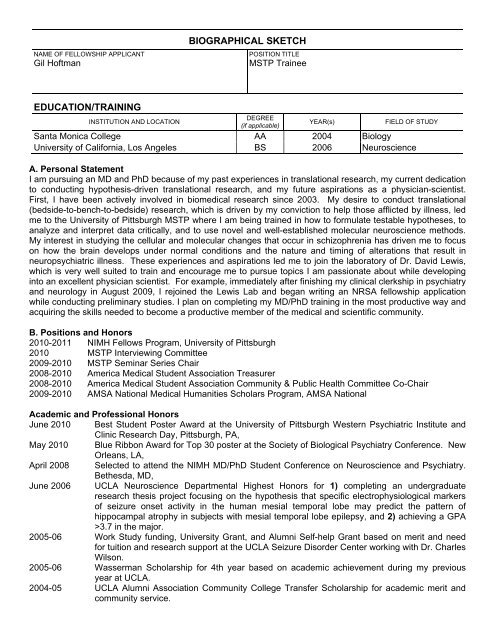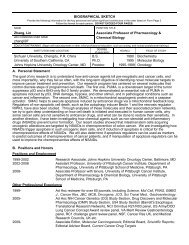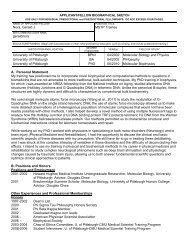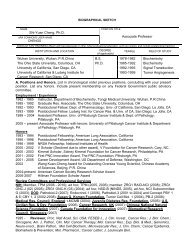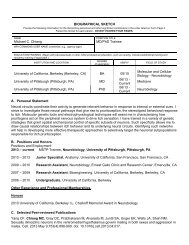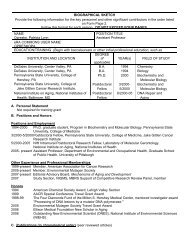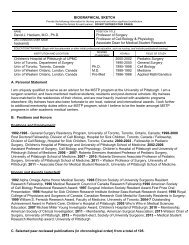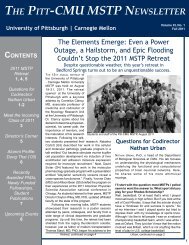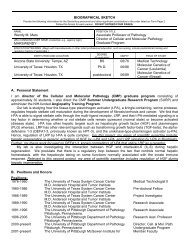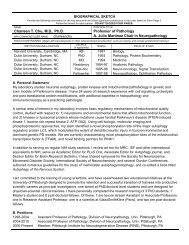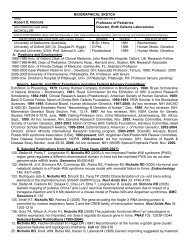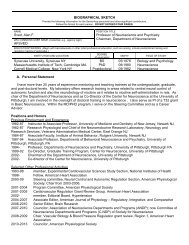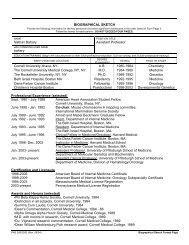NIH Biosketch - University of Pittsburgh :: MSTP
NIH Biosketch - University of Pittsburgh :: MSTP
NIH Biosketch - University of Pittsburgh :: MSTP
You also want an ePaper? Increase the reach of your titles
YUMPU automatically turns print PDFs into web optimized ePapers that Google loves.
NAME OF FELLOWSHIP APPLICANT<br />
Gil H<strong>of</strong>tman<br />
BIOGRAPHICAL SKETCH<br />
POSITION TITLE<br />
<strong>MSTP</strong> Trainee<br />
EDUCATION/TRAINING<br />
INSTITUTION AND LOCATION<br />
DEGREE<br />
(if applicable)<br />
YEAR(s)<br />
FIELD OF STUDY<br />
Santa Monica College AA 2004 Biology<br />
<strong>University</strong> <strong>of</strong> California, Los Angeles BS 2006 Neuroscience<br />
A. Personal Statement<br />
I am pursuing an MD and PhD because <strong>of</strong> my past experiences in translational research, my current dedication<br />
to conducting hypothesis-driven translational research, and my future aspirations as a physician-scientist.<br />
First, I have been actively involved in biomedical research since 2003. My desire to conduct translational<br />
(bedside-to-bench-to-bedside) research, which is driven by my conviction to help those afflicted by illness, led<br />
me to the <strong>University</strong> <strong>of</strong> <strong>Pittsburgh</strong> <strong>MSTP</strong> where I am being trained in how to formulate testable hypotheses, to<br />
analyze and interpret data critically, and to use novel and well-established molecular neuroscience methods.<br />
My interest in studying the cellular and molecular changes that occur in schizophrenia has driven me to focus<br />
on how the brain develops under normal conditions and the nature and timing <strong>of</strong> alterations that result in<br />
neuropsychiatric illness. These experiences and aspirations led me to join the laboratory <strong>of</strong> Dr. David Lewis,<br />
which is very well suited to train and encourage me to pursue topics I am passionate about while developing<br />
into an excellent physician scientist. For example, immediately after finishing my clinical clerkship in psychiatry<br />
and neurology in August 2009, I rejoined the Lewis Lab and began writing an NRSA fellowship application<br />
while conducting preliminary studies. I plan on completing my MD/PhD training in the most productive way and<br />
acquiring the skills needed to become a productive member <strong>of</strong> the medical and scientific community.<br />
B. Positions and Honors<br />
2010-2011 NIMH Fellows Program, <strong>University</strong> <strong>of</strong> <strong>Pittsburgh</strong><br />
2010 <strong>MSTP</strong> Interviewing Committee<br />
2009-2010 <strong>MSTP</strong> Seminar Series Chair<br />
2008-2010 America Medical Student Association Treasurer<br />
2008-2010 America Medical Student Association Community & Public Health Committee Co-Chair<br />
2009-2010 AMSA National Medical Humanities Scholars Program, AMSA National<br />
Academic and Pr<strong>of</strong>essional Honors<br />
June 2010 Best Student Poster Award at the <strong>University</strong> <strong>of</strong> <strong>Pittsburgh</strong> Western Psychiatric Institute and<br />
Clinic Research Day, <strong>Pittsburgh</strong>, PA,<br />
May 2010 Blue Ribbon Award for Top 30 poster at the Society <strong>of</strong> Biological Psychiatry Conference. New<br />
Orleans, LA,<br />
April 2008 Selected to attend the NIMH MD/PhD Student Conference on Neuroscience and Psychiatry.<br />
Bethesda, MD,<br />
June 2006 UCLA Neuroscience Departmental Highest Honors for 1) completing an undergraduate<br />
research thesis project focusing on the hypothesis that specific electrophysiological markers<br />
<strong>of</strong> seizure onset activity in the human mesial temporal lobe may predict the pattern <strong>of</strong><br />
hippocampal atrophy in subjects with mesial temporal lobe epilepsy, and 2) achieving a GPA<br />
>3.7 in the major.<br />
2005-06 Work Study funding, <strong>University</strong> Grant, and Alumni Self-help Grant based on merit and need<br />
for tuition and research support at the UCLA Seizure Disorder Center working with Dr. Charles<br />
Wilson.<br />
2005-06 Wasserman Scholarship for 4th year based on academic achievement during my previous<br />
year at UCLA.<br />
2004-05 UCLA Alumni Association Community College Transfer Scholarship for academic merit and<br />
community service.
2004-06 Granted membership to the Gold Shield Alumni <strong>of</strong> UCLA on the basis <strong>of</strong> academic<br />
performance and community service.<br />
C. Publications<br />
Peer-reviewed articles:<br />
H<strong>of</strong>tman GD and Lewis DA. Developmental trajectories <strong>of</strong> neural circuits in the primate prefrontal cortex:<br />
Identifying sensitive periods for vulnerability to schizophrenia. Schizophr Bull. Accepted 24 Feb 2011.<br />
Van Erp TG, Thompson PM, Kiesppä T, Bearden CE, Marino A, H<strong>of</strong>tman G, Haukka J, Partonen T, Huttenen<br />
M, Kaprio J, Lönnqvist J, Poutanen V-P, Toga AW, Cannon TD. Hippocampal morphology in twins discordant<br />
for bipolar I disorder. Human Brain Mapping. Accepted 19 November 2010.<br />
Ogren JA, Bragin A, Wilson CL, H<strong>of</strong>tman GD, Lin JJ, Dutton RA, Fields TA, Toga AW, Thompson PM, Engel J<br />
Jr, Staba RJ. Three-dimensional hippocampal atrophy maps distinguish two common temporal lobe seizureonset<br />
patterns. Epilepsia. Jun;50(6):1361-70. 2009. [Image on cover]<br />
Abstracts:<br />
H<strong>of</strong>tman GD, Bazmi HH, and Lewis DA. Developmental trajectories <strong>of</strong> markers <strong>of</strong> GABA neurotransmission in<br />
monkey prefrontal cortex. 40 th Annual Meeting <strong>of</strong> the Society for Neuroscience. 13-17 November 2010. San<br />
Diego, CA.<br />
H<strong>of</strong>tman GD, Bazmi HH, and Lewis DA. Developmental trajectories <strong>of</strong> transcripts regulating GABA<br />
neurotransmission in monkey prefrontal cortex. 65th Annual Meeting <strong>of</strong> the Society <strong>of</strong> Biological Psychiatry,<br />
20-22 May 2010, New Orleans, LA.<br />
Van Erp TG, Thompson PM, Kiesppä T, Bearden CE, Marino A, H<strong>of</strong>tman G, Haukka J, Partonen T, Huttenen<br />
M, Kaprio J, Lönnqvist J, Poutanen V-P, Toga AW, Cannon TD. Hippocampal morphology in twins discordant<br />
for bipolar I disorder. 39 th Annual Meeting <strong>of</strong> the Society for Neuroscience. 17-21 October 2009. Chicago,<br />
Illinois.<br />
Van Erp TG, Thompson PM, H<strong>of</strong>tman G, Huttenen M, Lönnqvist J, Kaprio J, Salonen O, Valanne L,<br />
Standertskjöld-Nordenstam C-G, Poutanen VP, Toga AW, Cannon TD. Hippocampal shape in twin pairs<br />
discordant for schizophrenia. Asilomar Conference. 26-29 October 2008. Pacific Grove, CA.<br />
D. Research Support<br />
Ongoing Research Support<br />
F30 MH093079-01 H<strong>of</strong>tman (PI) 01/01/11-12/31/14<br />
Developmental trajectories <strong>of</strong> prefrontal cortical GABA neurons and schizophrenia<br />
The goal <strong>of</strong> the proposed studies is to define the developmental trajectories <strong>of</strong> key components <strong>of</strong> prefrontal<br />
cortical circuitry that are sensitive to cannabis use and are altered in schizophrenia.<br />
Role: PI<br />
Completed Research Support<br />
T32 NS007433 Alan Sved (PI) 08/31/09-08/31/10<br />
<strong>University</strong> <strong>of</strong> <strong>Pittsburgh</strong>, Center for Neuroscience Training Grant<br />
Role: Trainee<br />
T32 GM008208-19 Clayton Wiley (PI) 06/01/07-06/01/08<br />
<strong>University</strong> <strong>of</strong> <strong>Pittsburgh</strong>, Medical Scientist Training Program Training Grant<br />
Role: Trainee


